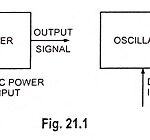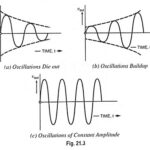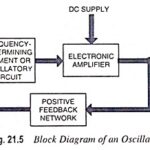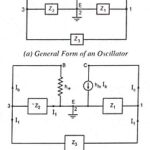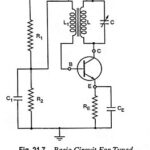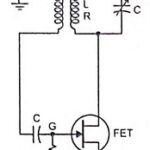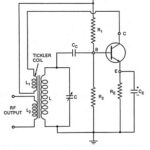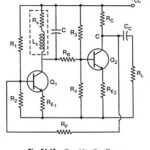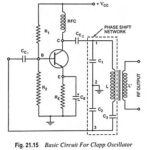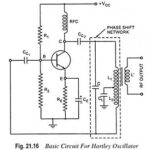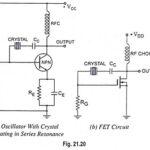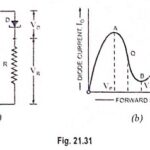Sinusoidal Oscillators Articles:
What is Oscillator? – Types of Oscillators: An oscillator is the basic element of all ac signal sources and generates sinusoidal signals of known frequency and amplitude. It is one of the basic and useful instruments used in electrical and electronic … (Read More)
Operation of Oscillator Circuit: The use of positive feedback that results in a feedback amplifier having closed-loop gain |Af| exceeding unity and satisfies the phase conditions results in operation as an oscillator circuit. An Operation of Oscillator Circuit then provides a … (Read More)
What are the Essential Components of an Oscillator? The Essential Components of an Oscillator are namely, Oscillatory circuit or frequency determining element. Amplifier. Positive feedback network. The oscillatory circuit or a frequency-determining element can be an inductance-capacitance network (L-C tank), resistance-capacitance (R-C network), or a … (Read More)
Frequency Stability of Oscillator: An oscillator having initially been set at a particular frequency does not maintain its initial frequency, but instead drift and wander about in frequency, sometimes uniformly in one direction, sometimes quite erratically. The frequency stability of an … (Read More)
Types of Transistor Oscillators: A transistor can be operated as an oscillator for producing continuous undamped oscillations of any desired frequency if tank (or oscillatory) and feedback circuits are properly connected to it. All types of transistor oscillators under different names … (Read More)
LC Oscillator Circuit – Definition, Types and Equation: Oscillators, which use inductance-capacitance (L-C) circuits as their tank or oscillatory circuits are called LC Oscillator. LC Oscillator are very popular for generating high-frequency outputs (e.g. 10 kHz to 100 MHz). There is … (Read More)
Tuned Collector Oscillator – Definition, Working and Equation: The basic circuit of a tuned collector oscillator is shown in Fig. 21.7. It is called the tuned collector oscillator, because the tuned circuit is connected to the collector. The tuned circuit, constituted … (Read More)
Tuned Drain Oscillator – Circuit Diagram and Equation: Tuned drain oscillator is similar to the tuned collector oscillator, and the basic circuit is given in Fig 21.10. Because of its high input impedance and high voltage gain, an FET can be used … (Read More)
Tuned Base Oscillator – Definition and Working Principle: When a parallel tuned L-C circuit is placed in the base-to-ground circuit, the oscillator is known as the tuned base oscillator. The basic circuit of a tuned base oscillator is shown in Fig. … (Read More)
Franklin Oscillator Circuit Diagram: A simple L-C oscillator, called the Franklin oscillator and its circuit diagram is shown in Fig. 21.12. Here two CE amplifier stages are employed to provide 360° phase shift from input to output. The values of the different components … (Read More)
Colpitts Oscillator using Transistor Circuit: The Colpitts oscillator circuit is a superb circuit and is widely used in commercial signal generators up to 100 MHz. The basic Colpitts Oscillator using Transistor circuit is shown in Fie. 21.13(a). It basically consists of a single … (Read More)
Clapp Oscillator – Circuit Diagram and Operation: The Clapp oscillator shown in Fig. 21.15 is a refinement of the Colpitt’s oscillator. The single inductor found in the Colpitt’s oscillator is replaced by a series L-C combination [See L and C3 in … (Read More)
Hartley Oscillator using Transistor Analysis: The transistor Hartley oscillator is as popular as Colpitt’s oscillator and is widely used as a local oscillator in radio receivers. The circuit arrangement is shown in Fig. 21.16. Hartley oscillator circuit is similar to Colpitt’s … (Read More)
Crystal Oscillators – Circuit, Working, Advantages and Disadvantages: In crystal oscillators, the usual electrical resonant circuit is replaced by a mechanically vibrating crystal. The crystal (usually quartz) has a high degree of stability in holding constant at whatever frequency the crystal … (Read More)
Negative Resistance Oscillators – Working and Types: Negative resistance oscillators make use of negative resistance elements such as tetrodes, tunnel diodes, unijunction transistors etc. There are two types of negative resistance oscillators, which are commonly used for high frequency generation. These … (Read More)
Selection of Oscillator: While in the Selection of Oscillator for a particular application, the following particulars are to be considered. Frequency Range: The oscillator selected for a particular application should be capable of supplying an output signal whose upper and lower frequency … (Read More)
